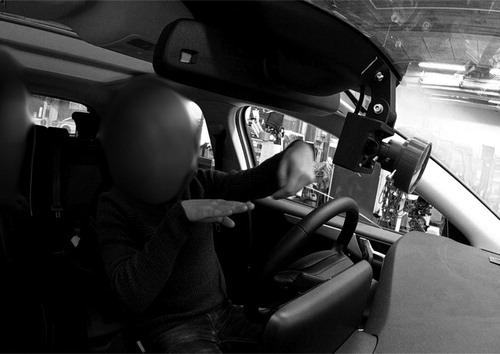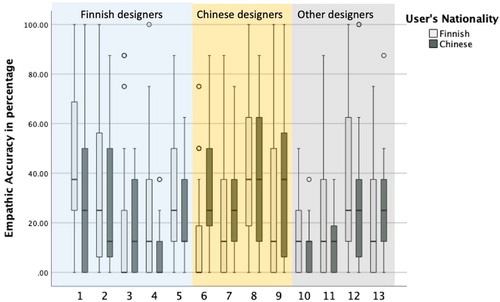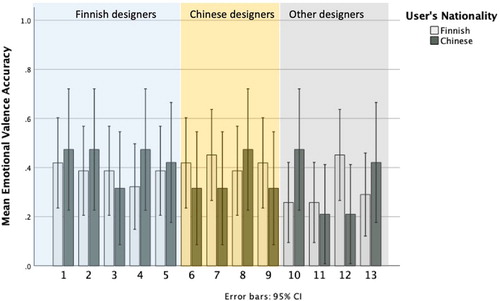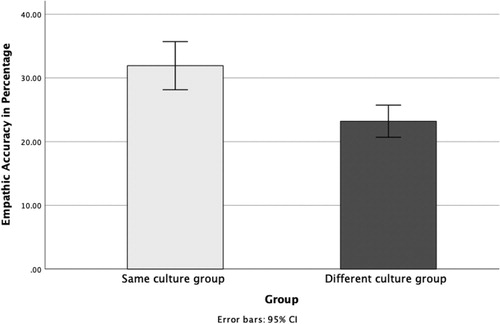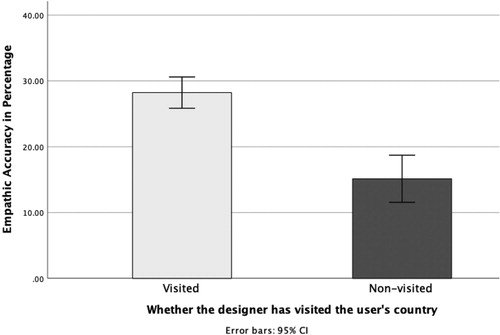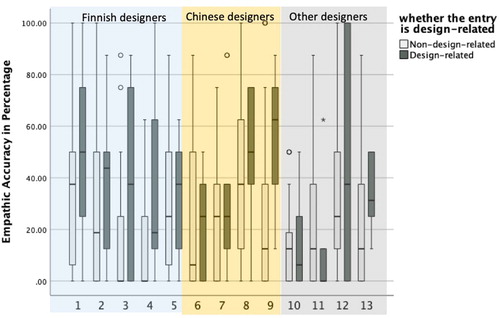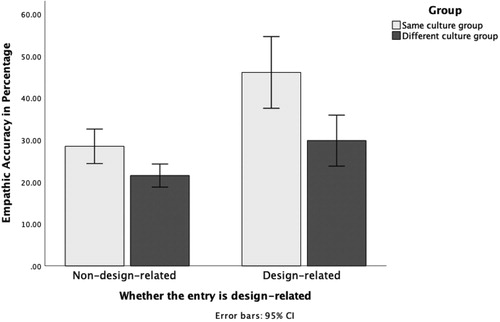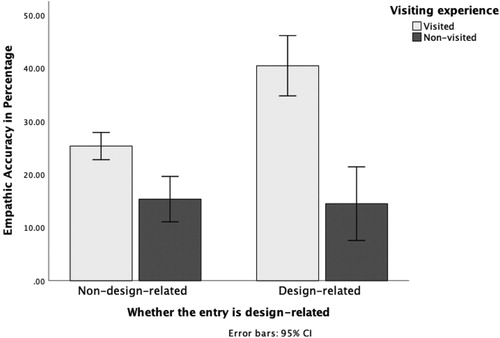 ?Mathematical formulae have been encoded as MathML and are displayed in this HTML version using MathJax in order to improve their display. Uncheck the box to turn MathJax off. This feature requires Javascript. Click on a formula to zoom.
?Mathematical formulae have been encoded as MathML and are displayed in this HTML version using MathJax in order to improve their display. Uncheck the box to turn MathJax off. This feature requires Javascript. Click on a formula to zoom.Abstract
For engineering design to be successful, it is essential to understand customer experience and identify customer needs. However, it is challenging to understand customers, especially those from different national cultures. The empathy literature suggests that having similar experiences to another person can help understand them better. This study adopts an empathy measure from psychology for use in a project where designers attempt to understand customers’ driving experiences in different countries and identify their needs for detecting road hazards. We quantify designers’ empathic accuracy and the correctness of their rating of customers’ emotional tone. The results show that national cultural differences significantly affect the accuracy of designers’ empathic understanding but do not impact their understanding of customers’ emotional tone.
Introduction
Understanding customers is essential. In engineering, we often develop technologies that have not previously existed. It is challenging to understand customer needs for novel technology since customers have not experienced it. For example, consider the case of the novel detection technology we are developing for personal motor vehicles for customers all over the world. Today, drivers often rely on their driving experience and rear-view mirrors to drive safely and to avoid obstacles. However, what if there were a new technology that could predict and report unexpected dangers on the road more accurately? What are the drivers’ needs? Do we understand these needs correctly? What are the differences between the needs of drivers from different countries? To answer these questions, designers should investigate target customers and understand their needs in various situations.
However, customers cannot express their expectations and needs, since they have not used the specific technology yet. To solve this problem, designers should understand customers from the customer point of view. Empathy is a way to build connections with customers and enhance the accuracy of understanding by metaphorically stepping into the customers’ shoes. In psychology, empathy is ‘the capacity to understand or feel what another person is experiencing from within their frame of reference’ (Bellet and Maloney Citation1991, 1831). In the field of design, McDonagh and Thomas (Citation2010) believe ‘empathy is the critical component that deepens the designer's understanding of users who may be very different from the designer’ (183). Koskinen (Citation2003) proposed that letting designers experience customers’ lives would help them acquire rich customer knowledge. Therefore, empathizing with customers is considered a way to achieve more accurate customer understanding.
If empathy helps designers understand customers, can it help designers better understand customers from different cultures? More specifically, can it be applied to the development of the road hazard detection device to better understand customer needs in their cultural contexts? Different cultural backgrounds lead to different customer habits, beliefs, and social contexts. Lachner et al. (Citation2015) believe that considering cultural differences in design helps designers to ‘create [a] culturally targeted, hence better product’ (p.68). Moreover, Clemmensen, Ranjan, and Bødker (Citation2018) find that culture-related knowledge shapes the reasoning patterns of design thinking. These elements tell us that cultural differences have an impact on design. However, how cultural differences influence customer understanding and what aspects of that understanding are impacted remain unclear.
This is the core research gap our paper addresses. More specifically, this study adopts an empathy measure from psychology to gauge how accurately designers can understand customers from different cultures. In this study, we specifically consider national cultural difference as one aspect of cultural difference. We hypothesize that national cultural differences will increase the difficulty of customer understanding, including understand customers’ cognitive mental content and emotional tone.
Research background
Understanding Customer Needs
Successful product design depends on the degree to which designers understand their target customers. The Kano model shows that customers’ satisfaction with a product is correlated with the extent to which customer requirements are fulfilled (Kano et al. Citation1984), or, in other words, ‘the higher [the] level of the fulfillment, the higher the customer's satisfaction’ (Sauerwein, et al.,Citation1996, 314). Moreover, in product design and development, a further reason for focusing on user needs over solutions is that needs tend to be less transient than solutions (Patnaik and Becker Citation1999). The most direct way to establish connections with customers and understand their needs is to interview them. However, Otto and Wood (Citation2001) claim that customers are likely to discuss the failings of the current product rather than their expectations. This reflects the way customers usually express their explicit needs regarding an existing product. Nevertheless, designers must also consider customers’ observable needs, tacit needs, and latent needs (Sanders Citation2002). To better develop novel technology and new products, designers should appreciate customers’ hopes and wishes, which often reflect their latent needs (Sanders Citation2002). Such needs might be related to the operation or usage situation of the product (Otto and Wood Citation2001). A contextual interview combined with scenarios is a way to discover latent customer needs because it does not limit customers and designers to existing products but stimulates them to identify a product’s future development. Scenarios are a narrative tool that provides ‘descriptions of a set of users, a work context, and a set of tasks that users perform or want to perform’ (Nardi Citation1992, 13). The application of scenarios in design ‘provides several coherent futures selected from an infinite number of possibilities’ (Cooper and Evans Citation2006, 71). A further method for better understanding customer needs involves establishing a physical connection through experiencing a functional prototype, product, or usage situation (Campbell et al. Citation2007; Johnson et al. Citation2014; Raviselvam, Hölttä-Otto, and Wood Citation2016). Other need-finding methods, such as questionnaires and focus groups, are also widely used (Otto and Wood Citation2001). However, these methods are not the main focus of our study, so they will not be discussed in more detail.
Empathy in Engineering Design
Within product design and development, empathic design is one approach to incorporating customer needs into the design process. Empathy is a way to experience customers’ situations and bridge the understanding gap between the designer and the customer (van Rijn et al. Citation2011). It encourages designers to challenge their preconceptions and immerse themselves in customers’ experiences. The process of empathizing in design includes the four phases of discovery, immersion, connection, and detachment (Kouprie and Visser Citation2009). The main empathic design methods are: 1) ethnographic methods, such as in-depth observation and interview, 2) empathic modelling, for example, ‘experiencing with your own body the physical situation’ (Thomas and McDonagh Citation2013, 4) and 3) empathic priming, which helps the designer gain inspiration by focusing on the verbal or visual attributes of customers (So and Joo Citation2017).
In-depth observations and interviews are the most direct way to connect with customers, but they require both time and money. Empathic modelling, such as wearing an aging suit or eye covers, provides a way for designers to simulate customers’ particular circumstances. Similar applications of empathic modelling are found in design studies for atypical customers, such as those with visual impairments or dementia (McDonagh and Thomas Citation2010; Cardoso and Clarkson Citation2012; Raviselvam, Hölttä-Otto, and Wood Citation2016). In addition, empathic priming is also essential in this area. This concept is adopted from psychology, indicating a psychological phenomenon where an individual’s exposure to a stimulus affects their response to subsequent stimuli (Weingarten et al. Citation2016). So and Joo (Citation2017) demonstrate that personas, as a part of empathic priming, help designers create an association between customers’ daily problems and designers’ self-experienced situations, thus facilitating idea generation. von Unold et al. (Citation2018) developed a peopleless persona on the basis of contextual empathic design to help designers understand users and intergrate knowledge of the users into design.
However, there are some limitations to applying empathic methods in product design. For example, Heylighen and Dong (Citation2019) state that empathy is compromised when there are large differences between designers and customers, and they believe the limitations of simulating customers’ experience stem from the ‘incompleteness of empathy’ (114). They also remind us to ‘respect the interpersonal differences among people’ and remain aware of ‘the eventual limits of knowing the experiences of others’ (119). Moreover, Kullman (Citation2016) argues that imitating customers’ daily life could not reflect the whole picture of customer experience. Instead, he believes in-depth observation and interaction with real users could identify user needs more efficiently. McDonagh and Thomas (Citation2010) combine ethnographic tools and empathic modelling in product design, and they believe this can help ‘provide designers with more relevant data’ (185). Nevertheless, how accurately a designer can empathize with a customer remains unclear. Chang-Arana, Piispanen, et al. (Citation2020) introduce a psychological measurement to engineering design research, providing a quantitative way to measure designers’ empathic understanding in design tasks. This is an initial step to understand how accurately a designer can empathize with a customer. We adopt the same measure in this paper.
Forms of Empathy in Psychology
In psychology, where empathy is well-studied, psychologists suggest two types of empathy: affective and cognitive. Specifically, the affective empathy comes from a person's instinct, and represents how a person reacts to emotional changes and shares feelings of others. The cognitive empathy is top-down controlled, and represents how a person infers another person's thoughts or feelings. Heyes (Citation2018) described the types of empathy as emotional contagion and empathic understanding. Emotional contagion comes from an innate instinct that represents a state in which emotions are also affected when people and some animals experience emotional changes (de Waal and Preston Citation2017). Empathic understanding is the ‘behaviour resulting from controlled processing’, and it ‘develops later, and, insofar as the controlled processing involves mindreading’ (Heyes Citation2018, 499). Cognitive empathy and affective empathy do not exist independently. Instead, they usually occur together. Reniers et al. (Citation2011) state that ‘general consensus requires empathy to encompass a comprehension of other people’s experience (cognitive empathy) as well as the ability to vicariously experience the emotional experience of others (affective empathy)’ (85). While affective empathy may be relevant or even a precursor of true understanding, cognitive empathy is often the goal in empathic design. In other words, the goal in engineering design is to form an empathic understanding of users. Thus, in engineering design, empathy refers to how designers actively take the users’ places, immerse themselves in the user experience and understand users in general (Kouprie and Visser Citation2009). Affective empathy might be in play during the immersion, but the final user understanding falls under cognitive empathy, and this is the focus of our study.
Measuring Empathy
Many methods can be used to measure empathy. Neumann et al. (Citation2015) aggregate empathy measures into three types: self-reported, behavioural, and neuroscientific measures. Since this paper is focused on the measure from psychology, we do not discuss neuroscientific measures here. Self-reported measures, such as the Interpersonal Reactivity Index (Chlopan et al. Citation1985), the Empathy Quotient (Baron-Cohen and Wheelwright Citation2004; Allison et al. Citation2011) and the Feeling and Thinking Scale (Garton and Gringart Citation2005), inviting participants self-rate a series of questions to evaluate their empathic ability. The main difference between self-report measures and behavioural measures is that self-report measures are sensitive to biases, while behavioral measures comprise subjects’ performance in experiments and are focused on measuring a person’s empathic concern, empathic accuracy or affective empathy. For example, Ickes (Citation1993) proposed a method called Empathy Accuracy Rating (EA). It is a performance-based behavioural measure to quantify cognitive empathy in a specific context in real time between two persons. It demonstrates similarities and differences between a person’s own mental states and another person’s inferences of them, and an emotional tone rating of the mental states (Ickes, Gesn, and Graham Citation2000). A person’s empathic accuracy is determined by the degree of similarity between the remembered and inferred mental contents of two interacting individuals, while the concept of emotional tone provides a basic reflection of the person’s positive, negative or neutral feelings.
The Influence of Cultural Differences on Empathic Understanding
Sociologists define culture as ‘the integrated and maintained system of socially acquired values, beliefs, and rules of conduct that impact on the range of accepted behaviours distinguishable from one societal group to another’ (Apgar Citation2018, 78). It is related to how people interact with the internal and external environment and how they understand the world and other people. Individuals come from the same nation or ethnicity usually share similar values, beliefs, behaviours and norms (Berrell Citation2021). Evidence from the fields of psychology and design show that cultural differences influence how a person understands another person. In the field of psychology, Soto and Levenson (Citation2009) find that individuals have significantly ‘greater physiological linkage’ when they are trying to understand a subject with the same ethnicity (882). Atkins, Uskul, and Cooper (Citation2016) state that cultural differences influence affective and cognitive empathy, including a person's response to another person's pain, empathic concern, and empathic accuracy. Casselss et al. (Citation2010) find that cultural differences influence on individuals' empathic responding. In design, McDonagh-Philp and Denton (Citation1999) suggest that everyone has a horizon of empathy, which defines ‘the individual's range of understanding of user experiences in different contexts’ (21). Many factors constitute this horizon, such as cultural background, educational level, social environment, empathic motivation, and perspective taking. Clemmensen, Ranjan, and Bødker (Citation2018) argue that ‘culture shapes design thinking’, while to frame design questions in a ‘culturally underspecified context’, designers need to make their knowledge more accessible in cross-cultural design (129). Moreover, a significant difference in designers’ empathic accuracy between understanding mobile payment users from the same and different national cultures has been found (Li and Hölttä-Otto Citation2020). Therefore, we believe cultural differences influence designers’ empathic understanding of customers.
Design case and research questions
The primary aim of this paper is to study how national cultural differences influence designers’ empathic accuracy of understanding customers in engineering design. The design challenge is a road obstacle detection device and the target customers are drivers.
RQ1: Do national cultural differences affect designers’ empathic accuracy of understanding customers?
RQ2: How do national cultural differences affect designers empathic understanding?
Methodology
Empathic Accuracy
In this study, we selected a method, namely Empathic Accuracy (EA), created by Ickes (Citation1993) to measure designers’ empathic understanding of customers. This performance-based method gives us a quantitative means to understand the accuracy of empathic understanding between individuals and has been used in design (Chang-Arana, Piispanen, et al. Citation2020). Specifically, it measures designers’ understanding accuracy of customers’ thoughts, feelings and emotional tone. We select EA for three reasons: 1) customer interview is widely used in needfinding. The EA method includes a face-to-face interaction with customers and thus EA provides a way to see how a designer understands a customer in a typical interview; 2) EA is a behavioural measure, which reflects how accurately a designer understands the customer's thoughts or feelings in real time; and 3) this method also includes an emotional tone rating, which addresses the designers’ empathic ability to recognise customers’ emotional changes through the context. Since the thoughts, feelings and emotional tone refer to how designers understand and infer customers’ mental state (i.e. cognitive empathy), and do not require an ability to share or have an emotional stimulation (i.e. affective empathy) (Kerr-Gaffney, Harrison, and Tchanturia Citation2019), this paradigm relates closely to cognitive empathy but involves emotional tone as a part of cognitive empathy.
Experimental Site & Demography
This experiment was conducted at the Vehicle Laboratory, where a detection device technology was under development (Komulainen Citation2019). Thus, this study also contributed to the design of a road hazard detection device. The customers in this paper are frequent drivers, having driving licenses is a mandatory requirement of recruiting participants. Participants are 13 designers (eight females, 61.5%) of varying design experience (from 10 months to 22 years) and two drivers (two males). Average age of them is 37.6 (maximum 44 and minimum 24). The 13 designers include five Finnish, four Chinese, a Portuguese, a Mexican, a Bulgarian, and a Canadian, while the two users comprise a Chinese and a Finnish. Designers were divided into three groups by their nationalities, namely the Finnish Designer Group (FDG), the Chinese Designer Group (CDG), and the Other Designer Group (ODG). The average design experience of designers in three groups are 9.2, 6.25, and 5.75 years, respectively. Because all the designers were recruited in Finland, the designers in the CDG and ODG were born and raised in their own countries while working or studying in Finland. In addition, there are four raters (two females and two males) rating the designers’ empathic accuracy. None of them are native English speakers, but their working and studying language is English. All of them are experienced researchers and fluent English speakers.
Experimental Procedure
The experiment (Figure ) was divided into two parts: Customer’s Participation and Designer’s Participation. The Customer’s Participation comprised a 20-30-minute semi-structured interview and a video review with each customer. The first author of this paper was the main interviewer, while the second author helped recording the interviews and organised the video review. Customers were first invited to a face-to-face interview in a car borrowed from the Vehicle Laboratory (Figure ). The interview aimed at understanding the customers’ driving experience during some extreme scenarios, such as driving in the darkness, heavy rain, and crowded intersections. The scenarios were selected as potentially relevant scenarios for the technology under development. After completing the interview, customers immediately went to another room to re-watch the recorded interview; paused the video when they recalled any thoughts or feelings during the interview; then wrote down their recalled thoughts and/or feelings at that moment and also completed the customer’s entry form (Table ). The form is combined with the paused time, the user’s thoughts and feelings, and emotional tone rating (+ means that the customer had a positive emotion at the moment; 0 means neutral; – means negative).
Table 1. Example of customer’s entry form.
The Designer’s Participation was organised as a separate session. Each designer was invited to watch the customer interviews individually. The interview video was paused at every point where the customer had paused it. The designer was asked to infer the customer’s feelings or thoughts, and rate the emotional tone. After that, the designer was asked to identify as many of the customer’s needs as they could and to provide some design ideas. Both tasks were to be completed within 15 min. We also recorded whether the designer had visited the customer’s country, since it may help designers better understand driving situation in the user’s country. Finally, all designers had a 5-10-minute discussion with the first author. The topics of the discussion included designers’ experience of the experiment, whether they have visited the customer’s country, and any questions they have of the customer, the experiment, or the road hazard detection device.
Evaluation
Four raters participated in the empathic accuracy evaluation step. They rated the similarity between the customer entries and designer inferences (Ickes Citation1993). Following Ickes’ protocol (Citation2000), the similarity between customer entries and designer inferences was evaluated using a three-point Likert scale from 0 to 2. A 0 was given if the texts were ‘essentially different content’; 1 if ‘somehow similar, but not the same content’; 2 if ‘essentially the same content’ (Table ). All customer and designer demographic information was hidden, and their answers were randomly arranged when evaluated. In addition, we compared the difference between users’ original emotional tone and designers’ assessment of the tone. The results are reported in Table .
Table 2. An example of similarity rating
Table 3. Examples of design-related ratings of users’ entries.
Table 4. Summary of Hierarchical Regression Analysis for Variables predicting Empathic Accuracy.
To further explain how national cultural differences affected designers’ understanding accuracy, we firstly assigned designers into two types of groups: 1) Same Cultural Group (SCG) if the designer and the customer were from the same country and Different Cultural Group (DCG); and 2) Visited Group if the designer had visited the customer's country and Non-visited Group. The cultural groups and visited groups were considered as independent variables. We only used the DCG group data in the visited / non-visited analysis. Table .
We are also interested in whether there is a difference in how well the designer understands the customer overall and how well they understand issues more directly linked to the design brief in question. In authors’ previous study, a significant difference of designers’ empathic accuracy between design-related and non-design-related inferences was found (Chang-Arana et al. Citation2020). The result tells that designers can achieve better empathic accuracy when understanding design-related entries. To understand whether design-relevance of users’ mental content influenced empathic understanding, we categorized the customers’ mental content into design-related and non-design-related entries in this study. Defining design-related users’ mental content was not a simple choice. Fully understanding the diversity of the users’ mental content could be helpful in design. Thus, we used a five-point Likert scale to assess how design-related a thought or a feeling was (1 = irrelevant; 2 = likely to be irrelevant; 3 = more or less relevant; 4 = likely to be relevant; 5 = highly relevant). The ratings were further anchored with a rationale describing the relevance (Table ). Entries were defined as design-related if they were rated with 4 or 5. Here, the relevance is considered as an independent variable.
Results
Overall, each designer inferred 50 entries from two customers (31 entries from the Finnish customer, and 19 entries from the Chinese customer). Each rater rated the similarity of 650 pairs between customers’ entries and designers’ inferences. The result of the rating is reliable (Cronbach’s Alpha = 0.78). The average score of each designer’s empathic accuracy and correct rate of inferring customers’ emotional tone are demonstrated as percentages (Figure & Figure ). Designers 1–5 are from Finland, designers 6–9 are from China, and designers 10–13 are from other western countries. Here, most designers achieved higher empathic accuracy scores when empathizing with the customer from the same country compared to empathising with a user from a different country. The difference was not observed in rating customers’ emotional tone. Table .
Table 5. Summary of Hierarchical Regression Analysis for Variables predicting Emotional Tone Accuracy.
Empathic accuracy and emotional tone accuracy
The K-S test result suggested that data of empathic accuracy came from a normally distributed population (D [26] = .09, p = .20). Since we had two non-independent variables, national culture and visiting experience of a designer, we selected a hierarchical linear model for our analysis. Therefore, variances according to designers’ visiting experience was nested within the variance by the national cultural difference. A two-stage hierarchical multiple regression was conducted with empathic accuracy and emotional tone as dependent variables here (Figures and ).
Figure 5. A hierarchical linear model of predicting variances of empathic accuracy and emotional tone under independent variables of national cultural differences and visiting experience.

From the result of statistical analysis, the National Cultural Differences contributed significantly to the regression model of predicting variance of designers’ empathic accuracy, F (1, 24) = 6.21, p = .020, and accounted for 20.6% of the variation in Empathic Accuracy. Combining with Visiting Experience explained additional 17.4% of the variation in Empathic Accuracy, F (2, 23) = 7.047, p = .004, and the change in R2 was significant, p = .018. Figure and Figure visualise the difference in empathic accuracy under the influences of National Cultural Differences and Visiting Experience. However, National Cultural Differences did not contribute significantly to the regression model of predicting variance of designers’ emotional tone accuracy, F (1, 24) = .047, p = .830. When combining with Visiting Experience, F (2, 23) = .025, p = .976, there was no significant change of R2, p = .950.
Figure 8. Comparison of designers’ empathic accuracy under the independent variable of whether the customer’s entry is design-related.

Design-Related and Non-Design-Related Empathic Accuracy
The second and fourth authors rated 50 customers’ entries independently, and the inter-reliability of the rating scheme was checked (Cohen's weighted Kappa = 0.68). After the relevance rating, we found six design-related and 25 non-design-related entries from the Finnish customer, while the Chinese customer had five design-related and 14 non-design-related entries. In total, 13 designers inferred 143 design-related and 507 non-design-related inferences. The data was normally distributed. The empathic accuracy of 143 design-related inferences was higher than 507 non-design-related inferences, while the difference was significant (p = .000) (Table & Figure ).
Table 6. Comparison of designers’ empathic accuracy of inferring design-related and non-design-related entries.
To understand whether national cultural differences and visiting experience influenced design-related and non-design-related empathic accuracy, we first divided each designer’s overall empathic accuracy into design-related and non-design-related empathic accuracy (Figure ). A two-stage hierarchical multiple regression was conducted with design-related and non-design-related empathic accuracy as dependent variables here (Figure ). Tables and .
Figure 10. A hierarchical linear model of predicting variances of design-related and non-design-related empathic accuracy under independent variables of national cultural differences and visiting experience.

Table 7. Summary of Hierarchical Regression Analysis for Variables predicting Design-related Empathic Accuracy.
Table 8. Summary of Hierarchical Regression Analysis for Variables predicting Non-design-related Empathic Accuracy.
From the result of statistical analysis at Step one, the National Cultural Differences contributed significantly to the regression model of predicting variance of both design-related and non-design-related empathic accuracy, Fdesign-related (1, 24) = 4.867, p = .037, and Fnon-design-related (1, 24) = 5.822, p = .024. The National Cultural Differences accounted for 16.9% of the variation in Design-related Empathic Accuracy and 19.5% of the variation in Non-design-related Empathic Accuracy. Combining with Visiting Experience explained additional 18.1% of the variation in Design-related Empathic Accuracy, F (2, 23) = 6.181, p = .007, and the change in R2 was significant, p = .019. The combination of independent variable also explained additional 11.8% of the variation in Non-design-related Empathic Accuracy, F (2, 23) = 5.246, p = .013, and the change in R2 was significant, p = .059. Figure and Figure visualised the differences of design-related and non-design-related empathic accuracy under influences of the National Cultural Differences and Visiting Experience.
Examples of different and similar opinions from designers and customers
In addition to the quantitative scores, we listened to the recorded brief discussions we had with designers after their experiment participation. The quotes (Table ) qualitatively reflected how customers and designers thought when they talked about the same topic. This provided further insight into how designers understood customers, be it accurately or inaccurately.
Table 9. Examples of opinions from designers and customers under the same topic
Discussion
This study suggests that the national cultural differences affect the accuracy of designers’ empathic understanding in the early phases of engineering design. By investigating designers’ inferences of customers’ thoughts and feelings at specific time points in semi-structured interviews, we find that the inferences are more accurate for customers who are from the same culture as the designer. Our results indicate that familiarity with the customer’s context in terms of sharing a cultural background, or even through a short-period visiting, increases the accuracy of empathic understanding. Van der Linden, Dong, and Heylighen (Citation2019) have theorised the benefits of user research, and it is heavily recommended by design practitioners (Mattelmäki, Vaajakallio, and Koskinen Citation2014; Smeenk, Tomico Plasencia, and van Turnhout Citation2016), but this study is among the first to quantitatively measure the influence of national cultural differences on empathic understanding. Even a short and potentially generic immersion (e.g. a working trip in the user’s home country) has a large and statistically significant effect on empathic understanding accuracy. For example, under the entry of Potential Dangers Caused by Animals when Driving in Dark Rural Areas (Table ), all the designers who had visited China achieved empathic accuracy scores from 25% to 100%, while the designers who had never visited China received scores from 0% to 25% for a single inference. The examples in Table provide qualitative insight into this difference. The designers who had visited China demonstrated a better understanding of Chinese road conditions and customer needs. This phenomenon reminds us that understanding customers in their own situations is important. The differences in different customers’ living situations increases the difficulty of understanding customers in a cross-cultural design context.
Moreover, we find that the customers’ thoughts or feelings during the interview are not always about their own needs or the product. Most of their mental contents focus on their personal life, feelings about the interview, or something irrelevant to the product. These differences persist in different types of user thoughts and feelings, namely those directly related to the design brief and those not directly related. An increase in empathic accuracy is found in both SCG and DCG when designers inferred design-related entries. It is reassuring that while the overall empathic accuracy was quite low, it was higher for the design-related thoughts and feelings. This phenomenon is independent of how accurately individual designers understood the users overall. For example, when discussing the Reliability of the Road Hazard Detection Device and the Curiosity towards technology (Table ), both which are design-related entries, most designers show accurate empathic understanding. However, when the design-related entry is closely related to cultural elements, the designers who are from the customer’s country demonstrated more accurate understanding, such as in the example of Necessity of Technology (Table ). Under this topic, a Chinese designer who accurately infer the customer’s mental contents has been asked how she achieved such high accuracy, and she struggled in explaining her thought inferring process. She said that there was no explicit facial expression or body language from the customer that would have been responsible for neither her inferring of a disliking feeling toward the technology nor making her feel confident about the customer’s driving experience. The only reason to her inference was that her friends and families, who are from the same national culture as the customer, used to express similar feelings in a similar way. Overall, this case provides further insight into how national cultural differences can influence the ways in which designers understand customers.
Furthermore, neither national cultural differences nor visiting experience influences designers’ accuracy of inferring customers’ emotional tones. Even between the top and bottom performers in overall empathic accuracy, the accuracy of inferring customers’ emotional tones remains similar. Although understanding both emotional tones and mental contents is conceptually a part of cognitive empathy, our results indicate that accurately inferring customers’ emotional tones does not translate into the accuracy of inferring customers’ mental contents. When we empathize with someone, it is natural to guess the person’s feelings. However, the role of the emotional tone rating in the cognitive empathy measure remains unclear. It will be interesting to discover the connection between emotional tone and empathic accuracy in future research.
Limitations
As mentioned in the results section, the sample size of this study is small. We are still looking for more participants to increase the diversity of both the designer and user samples. Moreover, all the designers in the CDG and ODG were working in Finland at the time of their participation. This might influence their empathic understanding of Finnish users since they are familiar with Finnish culture. This study didn’t investigate connections of empathic accuracy and design outcomes. Future studies are needed to explore the relationship between designers’ empathic accuracy and their performance in needs identification and ideation.
Conclusion
In this study, we measured designers’ empathic accuracy and accuracy of inferring customers’ emotional tones under the influence of cultural differences and design-relevance. The main results are:
National cultural differences and visiting experiences influence designers’ empathic accuracy significantly.
Designers’ understanding is more accurate when the customer's mental contents are design-related.
Neither cultural differences nor visiting experiences influence designers’ accuracy of inferring customers’ emotional tones.
Overall, these results quantitatively indicate that observer-target similarity influences how well a designer can initially understand a customer. Although statistical results show that national cultural differences and visiting experience only predict approximately 31% to 38% of empathic accuracy, the significant differences highlight the essential role of national cultural differences in empathizing with customers. This partly confirms the theory developed by Heylighen and Dong (Citation2019), who suggest that embodiment, in another word, the designer either having had or being able to imagine similar experiences as the user, is crucial in designer-user understanding. According to our results, even when the design context, such as everyday driving, is familiar to both the designer and the user, cultural differences can make embodiment difficult. In future work, it would be interesting to study how different types of observer-target dissimilarity influence empathic accuracy. Similar results, namely contextual knowledge improving empathic accuracy, have been obtained in various social psychological studies, where differences in interpersonal understanding have been compared between friends and strangers.
Acknowledgement
This work is supported by CSC (Chinese Scholarship Council), the ‘Future Makers’ grant of the Technology Industries of Finland Centennial Foundation and Jane and Aatos Erkko Foundation. We also wish to thank Professor Kari Tammi, Xiaoqi Feng, and all the participants for their help.
Disclosure statement
No potential conflict of interest was reported by the author(s).
Additional information
Funding
References
- Allison, C., S. Baron-Cohen, S. Wheelwright, M. Stone, and S. Muncer. 2011. “Psychometric Analysis of the Empathy Quotient (EQ).” Personality and Individual Differences, 51 (7): 829–835.
- Apgar, D. 2018. Social Work ASWB: Advanced Generalist Practice Test, 170 Questions to Identify Knowledge Gaps. New York: Springer.
- Atkins, D., A. K. Uskul, and N. R. Cooper. 2016. “Culture Shapes Empathic Responses to Physical and Social Pain.” Emotion, 16 (5): 587–601.
- Baron-Cohen, and S. Wheelwright. 2004. “The Empathy Quotient: An Investigation of Adults with Asperger Syndrome or High Functioning Autism, and Normal Sex Differences.” Journal of Autism and Developmental Disorders Volume, 34(2): 163–175.
- Bellet, P., and M. Maloney. 1991. “The Importance of Empathy as an Interviewing Skill in Medicine.” JAMA: the Journal of the American Medical Association, 266 (13): 1831–1832.
- Berrell, Mike. 2021. “National Culture and the Social Relations of Anywhere Working.” In Anywhere Working and the Future of Work, edited by Yvette Blount and Marianne Gloet, 23–59. Hershey, PA: IGI Global. doi:https://doi.org/10.4018/978-1-7998-4159-3.ch002.
- Campbell, R., D. De Beer, L. Barnard, G. Booysen, M. Truscott, R. Cain, … R. Hague. 2007. “Design Evolution Through Customer Interaction with Functional Prototypes.” Journal of Engineering Design, 18(6): 617–635.
- Cardoso, C., and P. Clarkson. 2012. “Simulation in User-Centred Design: Helping Designers to Empathise with Atypical Users.” Journal of Engineering Design 23 (1): 1–22.
- Casselss, T. G., S. Chan, W. Chung, and S. A. Birch. 2010. “The Role of Culture in Affective Empathy: Cultural and Bicultural Differences.” Journal of Cognition and Culture, 10(3-4): 309–326.
- Chang-Arana, ÁM, M. Piispanen, T. Himberg, A. Surma-aho, J. Alho, M. Sams, and K. Hölttä-Otto. 2020. “Empathic Accuracy in Design: Exploring Design Outcomes Through Empathic Performance and Physiology.” Design Science, 6: 1–34.
- Chang-Arana, A. M., A. Surma-aho, J. Li, M. C. Yang, and K. Hölttä-Otto. 2020. “Reading the User's Mind: Designers Show High Accuracy in Inferring Design-Related Thoughts and Feelings.” ASME 2020 International Design Engineering Technical Conferences and Computers and Inforamtion in Engineering Conference IDETC/CIE 2020, V008T08A029-01-V008T08A029-13.
- Chlopan, B. E., M. L. McCain, J. L. Carbonell, and R. L. Hagen. 1985. “Empathy: Review of Available Measures.” Journal of Personality and Social Psychology, 48(3): 635–653.
- Clemmensen, T., A. Ranjan, and M. Bødker. 2018. “How Cultural Knowledge Shapes Core Design Thinking—a Situation Specific Analysis.” CoDesign, 14(2): 115–132. doi:https://doi.org/10.1080/15710882.2017.1399146.
- Cooper, R., and M. Evans. 2006. “Breaking from Tradition: Market Research, Consumer Needs, and Design Futures.” Design Management Review 17 (1): 68–74.
- de Waal, F. B., and S. D. Preston. 2017. “Mammalian Empathy: Behavioural Manifestations and Neural Basis.” Nature Reviews Neuroscience Volume, 18(8): 498–509.
- Garton, A. F., and E. Gringart. 2005. “The Development of a Scale to Measure Empathy in 8- and 9-Year Old Children.” Australian Journal of Educational & Developmental Psychology, 5: 17–25.
- Heyes, C. 2018. “Empathy is not in our Genes.” Neuroscience and Biobehavioral Reviews, 95: 499–507.
- Heylighen, A., and A. Dong. 2019. “To Empathise or not to Empathise? Empathy and its Limits in Design.” Design Studies, 65: 107–124.
- Ickes, W. 1993. “Empathic Accuracy.” Journal of Personality, 61(4): 587–610.
- Ickes, W., P. R. Gesn, and T. Graham. 2000. “Gender Differences in Empathic Accuracy: Differential Ability ot Different Motivation?” Personal Relationship, 7(1): 95–109.
- Johnson, D. G., N. Genco, M. N. Saunders, P. Williams, C. C. Seepersad, and K. Hölttä-Otto. 2014. “An Experimental Investigation of the Effectiveness of Empathic Experience Design for Innovative Concept Generation.” Journal of Mechanical Design 136 (5): 051009-01-051009-12.
- Kano, N., N. Seraku, F. Takahashi, and S. Tsuji. 1984. “Attractive Quality and Must-be Quality.” The Journal of the Japanese Society for Quality Control, 14: 39–48.
- Kerr-Gaffney, J., A. Harrison, and K. Tchanturia. 2019. “Cognitive and Affective Empathy in Eating Disorders: A Systematic Review and Meta-Analysis.” Frontiers in Psychiatry, 10: 102. doi:https://doi.org/10.3389/fpsyt.2019.00102.
- Komulainen, T. 2019. Vehicle Interface Product Development Process. Helsinki, Finland: Aalto University.
- Koskinen, I. 2003. “Empathic Design in Methodic Terms.” In Empathic Design: User Experience in Product Design, edited by I. Koskinen, T. Mattelmäki, and K. Battarbee, 59–65. Helsinki: IT Press.
- Kouprie, M., and F. S. Visser. 2009. “A Framework for Empathy in Design: Stepping Into and out of the User’s Life.” Journal of Engineering Design, 20(5): 437–448.
- Kullman, K. 2016. “Prototyping Bodies: A Post-Phenomenology of Wearable Simulations.” Design Studies, 47: 73–90.
- Lachner, F., C. von Saucken, F. F. Mueller, and U. Lindemann. 2015. “Cross-Cultural User Experience Design Helping Product Designers to Consider Cultural Differences.” In Cross-Cultural Design, Methods, Practice and Impact: 7th International Conference, CCD 2015 Held as Part of HCI International 2015, 58–70. Springer, Cham.
- Li, J., and K. Hölttä-Otto. 2020. “The Influence of Designers’ Cultural Differences on the Empathic Accuracy of User Understanding.” The Design Journal 23 (5): 779–796.
- Mattelmäki, T., K. Vaajakallio, and I. Koskinen. 2014. “What Happened to Empathic Design?” Design Issues, 30(1): 67–77.
- McDonagh-Philp, D., and H. Denton. 1999. “Using Focus Groups to Support the Designer in the Evaluation of Existing Products: A Case Study.” The Design Journal, 13(2): 20–31.
- McDonagh, D., and J. Thomas. 2010. “Disability + Relevant Design: Empathic Design Strategies Supporting More Effective New Product Design Outcomes.” The Design Journal, 2(2): 180–198.
- Nardi, B. A. 1992. “The Use of Scenarios in Design.” ACM: SIGCHI Bulleti 24 (4): 13–14.
- Neumann, D. L., R. C. Chan, G. Boyle, Y. Wang, and H. R. Westbury. 2015. “Measures of Empathy: Self-Report, Behavioral, and Neuroscientific Approaches.” In Personality and Social Psychological Constructs, edited by G. J. Boyle, D. H. Saklofske, and G. Matthews, 257–289. San Diego: Academic Press.
- Otto, K., and K. Wood. 2001. “Chapter 4: Understanding Customer Needs.” In Product Design: Techniques in Reverse Engineering and new Product Development, edited by K. Otto and K. Wood, 111–145. Upper Saddle River, NJ: Prentice Hall cop.
- Patnaik, D., and R. Becker. 1999. “Needfinding: the way and how of Uncovering People's Needs.” Design Management Journal, 10(2): 37–43.
- Raviselvam, S., K. Hölttä-Otto, and K. L. Wood. 2016. “User Extreme Conditions to Enhance Designer Empathy and Creativity: Applications Using Visual Impairment.” In Proceedings of the ASME 2016 International Design Engineering Technical Conferences and Computers and Information in Engineering Conference. Volume 7: 28th International Conference on Design Theory and Methodology, V007T06A005-01- 09, Charlotte, North Carolina, USA: ASME.
- Reniers, R. L., R. Corcoran, R. Drake, N. M. Shryane, and B. A. Völlm. 2011. “The QCAE: A Questionnaire of Cognitive and Affective Empathy.” Journal of Personality Assessment 93 (1): 84–95.
- Sanders, E. B.-N. 2002. “From User-Centered to Participatory Design Approaches.” In J. Frascara, Design and the Social Sciences: Making Connections, edited by J.Frascara, 1–8. CRC Press.
- Sauerwein, E., F. Bailom, K. Matzler, and H. H. Hinterhuber. 1996. “THE KANO MODEL: HOW TO DELIGHT YOUR CUSTOMERS.” Preprints Volume I of the IX. International Working Seminar on Production Economics, 1 (4): 313–327.
- Smeenk, W., O. Tomico Plasencia, and K. G. van Turnhout. 2016. “A Systematic Analysis of Mixed Perspectives in Empathic Design: not one Perspective Encompasses all.” International Journal of Design, 10(2): 31–48. http://ijdesign.org/ojs/index.php/IJDesign/article/view/2543/738.
- So, C., and J. Joo. 2017. “Does a Persona Improve Creativity?” The Design Journal, 20(4): 459–475.
- Soto, J. A., and R. W. Levenson. 2009. “Emotion Recognition Across Cultures: The Influence of Ethnicity on Empathic Accuracy and Physiological Linkage.” Emotion, 9(6): 874–884. doi:https://doi.org/10.1037/a0017399.
- Thomas, J., and D. McDonagh. 2013. “Empathic Design: Research Strategies.” AMJ 6 (1): 1–6. doi:https://doi.org/10.4066/AMJ.2012.1575.
- Van der Linden, V., H. Dong, and A. Heylighen. 2019. “Tracing Architects’ Fragile Knowing About Users in the Socio-Material Environment of Design Practice.” Design Studies, 63: 65–91.
- van Rijn, H., F. S. Visser, P. J. Stappers, and A. D. Özakar. 2011. “Achieving Empathy with Users: the Effects of Different Sources of Information.” International Journal of CoCreation in Design and the Arts, 7(2): 65–77.
- von Unold, B., A. I. Böhmer, T. A. Björklund, N. Ledl, U. Lindemann, G. Toye, and S. Sheppard. 2018. “Implications of Contextual Empathic Design for Engineering Education.” In 2018 ASEE Annual Conference & Exposition (ASEE Annual Conference & Exposition Proceedings), 22297. American Society for Engineering Education, Salt Lake City, UT.
- Weingarten, E., Q. Chen, M. McAdams, J. Yi, J. Hepler, and D. Albarracín. 2016. “From Primed Concepts to Action: A Meta-Analysis of the Behavioral Effects of Incidentally Presented Words.” Psychological Bulletin 142 (5): 472–497.


